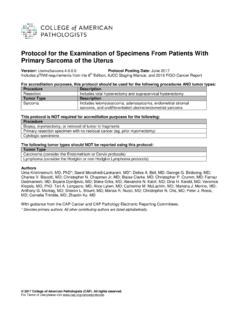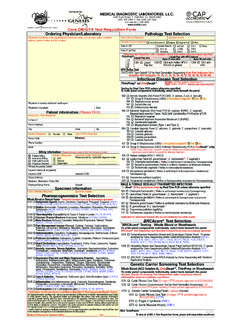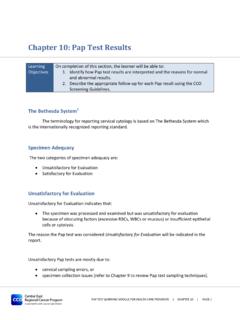Transcription of Cervical Cancer Screening Guidelines for Average …
1 Cervical Cancer Screening Guidelines for Average -Risk Womena American Cancer Society (ACS), American Society for Colposcopy and Cervical pathology (ASCCP), and American Society for Clinical pathology (ASCP)1 2012 Preventive Services Task Force (USPSTF)2 2012 American College of Obstetricians and Gynecologists (ACOG)3 2012 Society of gynecologic Oncology (SGO) and the American Society for Colposcopy and Cervical pathology (ASCCP): Interim clinical guidance for primary hrHPV testing4 2015 When to start screeningb Age 21.
2 Women aged <21 years should not be screened regardless of the age of sexual initiation or other risk factors. Age 21. (A recommendation) Recommend against Screening women aged <21 years (D recommendation). Age 21 regardless of the age of onset of sexual activity. Women aged <21 years should not be screened regardless of age at sexual initiation and other behavior-related risk factors (Level A evidence). Refer to major Guidelines . Statement about annual Screening Women of any age should not be screened annually by any Screening method. Individuals and clinicians can use the annual Pap test Screening visit as an opportunity to discuss other health problems and preventive measures.
3 Individuals, clinicians, and health systems should seek effective ways to facilitate the receipt of recommended preventive services at intervals that are beneficial to the patient. Efforts also should be made to ensure that individuals are able to seek care for additional health concerns as they present. In women aged 30 65 years, annual Cervical Cancer Screening should not be performed. (Level A evidence) Patients should be counseled that annual well-woman visits are recommended even if Cervical Cancer Screening is not performed at each visit. Not addressed. Screening method and intervals Cytology (conventional or c liquid based)21 29 years of age Every 3 Every 3 years (A recommendation).
4 Every 3 years (Level A evidence). Not addressed. 30 65 years of age Every 3 Every 3 years (A recommendation). Every 3 years (Level A evidence). Not addressed. HPV co-test (cytology + HPV test administered together) 21 29 years of age HPV co-testing should not be used for women aged <30 years. Recommend against HPV co-testing in women aged <30 years (D recommendation). HPV co-testinge should not be performed in women aged <30 years. (Level A evidence ) Not addressed. 30 65 years of age Every 5 years; this is the preferred method. For women who want to extend their Screening interval, HPV co-testing every 5 years is an option (A recommendation).
5 Every 5 years; this is the preferred method (Level A evidence). Not addressed. Primary hrHPV f testing (as an alternative to cotesting or g cytology alone)For women aged 30 65 years, Screening by HPV testing alone is not recommended in most clinical Recommend against Screening for Cervical Cancer with HPV testing (alone or in combination with cytology) in women aged <30 years (D recommendation). Not addressed. Every 3 years. Recommend against primary hrHPV Screening in women aged <25 years of age. i When to stop Screening Aged >65 years with adequate negative prior Screening * and no history of CIN2 or higher within the last 20 *Adequate negative prior Screening results are defined as 3 consecutive negative cytology results or 2 consecutive negative co-test results within the previous 10 years, with the most recent test performed within the past 5 years.
6 Aged >65 years with adequate Screening history* and are not otherwise at high risk for Cervical cancerj (D recommendation). Aged >65 years with adequate negative prior Screening * results and no history of CIN 2 or higherj (Level A evidence). Not addressed.
7 When to screen after age 65 years Aged >65 years with a history of CIN2 CIN2, CIN3, or adenocarcinoma in situ, routine screeningk should continue for at least 20 years.
8 Women aged >65 years who have never been screened, do not meet the criteria for adequate prior Screening , or for whom the adequacy of prior Screening cannot be accurately accessed or Routine screeningk should continue for at least 20 years after spontaneous regression or appropriate management of a high-grade precancerous lesion, even if this extends Screening past age 65 years. Certain considerations may support Screening in women aged > 65 years who are otherwise considered high risk (such as women with a high-grade precancerous lesion or Cervical Cancer , women with in utero exposure to diethylstilbestrol, or women who are immunocompromised).
9 Women aged >65 years with a history of CIN2, CIN3, or AIS should continue routine age-based screeningk for at least 20 years (Level B evidence). Not addressed. Screening post-hysterectomy Women who have had a total hysterectomy (removal of the uterus and cervix) should stop Women who have had a supra- Cervical hysterectomy (cervix intact) should continue Screening according to Guidelines . Recommend against Screening in women who have had a hysterectomy (removal of the cervix)n (D recommendation). Women who have had a hysterectomy (removal of the cervix) should stop Screening and not restart for any reasonn,o (Level A evidence).
10 Not addressed. The need for a bimanual pelvic exam Not addressed in 2012 Guidelines but was addressed in 2002 ACS Addressed in USPSTF ovarian Cancer Screening recommendations (draft).q Addressed in 2012 well-woman visit Aged <21 years, no evidence supports the routine internal examination of the healthy, asymptomatic patient. An external-only genital examination is acceptable. Aged 21 years, no evidence supports or refutes the annual pelvic examination or speculum and bimanual examination. The decision whether or not to perform a complete pelvic examination should be a shared decision after a discussion between the patient and her health care provider.
















